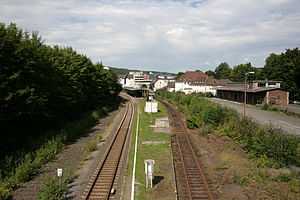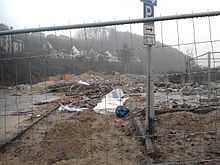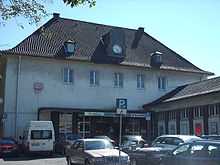Gummersbach station
Gummersbach | |
|---|---|
| Through station | |
 | |
| Location |
Gummersbach, North Rhine-Westphalia Germany |
| Coordinates | 51°01′24″N 7°34′01″E / 51.023325°N 7.567037°ECoordinates: 51°01′24″N 7°34′01″E / 51.023325°N 7.567037°E |
| Line(s) | |
| Platforms | 2 |
| Other information | |
| Station code | 2410[1] |
| DS100 code | KGU[2] |
| Category | 5[1] |
| History | |
| Opened | 1 July 1893 [3] |


Gummersbach station is on the Hagen–Dieringhausen railway and serves central Gummersbach in the Oberbergische district. Until the 1980s, Dieringhausen station, which is also in Gummersbach, was more important for the city as it had a rail workshop and was a railway junction. Gummersbach station only became more important with the closing of branch lines in the Oberbergische district and the associated loss of significance for Dieringhausen.
Lack of traffic means that the tracks are now reduced to the basics. The stations's buildings were torn down in January 2012 in preparation for road works after years of disuse.
History
The first station called Gummersbach was in Niedersessmar. In 1893, with the opening of the Hagen–Dieringhausen railway (Volme Valley Railway) from Dieringhausen to Brügge, it was renamed Niedersessmar. Since then Gummersbach station has served the town centre.
The entrance building in Gummersbach, which was demolished in 2012, was first built in 1937 when the old building was too small.
Former lines
The following routes formerly stopped at the station:
- the Wiehl Valley Railway (until 1965), which connected to the Wisser Valley Railway (until 1960) to Waldbröl and Morsbach
- the Volme Valley Railway train from Brügge and Lüdenscheid, continuing to Hagen and Wuppertal (until 1986/87)
- the Wipper Valley Railway to Wipperfürth, Hückeswagen and Remscheid-Lennep (until 1985/86)
- the Siegburg–Olpe railway and Cologne–Overath railway to Siegburg (until 1954/56), Cologne (to date), Olpe (until 1979).
Not all trains ran over the whole routes shown above and some services only lasted a few years. For example:
- Most trains to Olpe ran from Dieringhausen.
- After the construction of the tunnel at Hoffnungsthal in 1910, the line between Overath and Siegburg was served only be regional services and no direct trains ran to Gummersbach.
- Direct connections to Morsbach usually ran only from Waldbröl and Hermesdorf.
Current situation
Today, the station has only a through platform track and a platform track ending at a buffer stop. In the course of the reactivation of the Volme Valley Railway between Marienheide and Meinerzhagen, the latter will be reconnected as part of planned duplication of the line between Dieringhausen and Gummersbach. There are actually two tracks towards Dieringhausen, but one track was closed years ago and is currently separated and overgrown. New signals were also built several years ago in the middle of the second track in some places. All other tracks, including a comprehensive network of freight tracks, and facilities were demolished a few years ago, as was the former railway siding of the defunct company L. & C. Steinmüller. The site of the former railway land has been converted into a large, stretched parking area. Deutsche Bahn has not operated freight transport in the Oberbergische district since 1997, except for freight traffic on the Wiehl Valley Railway, which was re-established in 1999.
The two signal boxes in the station area are no longer used operationally. One of the two signal boxes is used by the local savings bank for training, while the other is unused at the exit to Dieringhausen. A road underpass was built near the station in 2009, which will connect the town centre with the Steinmueller area. Near the station there is a new campus of the Gummersbach branch of the Cologne University of Applied Sciences, which can be reached via a metal footbridge. The station building was demolished in January 2012.
The state of the platform is worse than at other stations on the line. The station is served by the following service:[4]
| Line | Route | Frequency | Rollingstock |
|---|---|---|---|
| RB 25 | Cologne - Rösrath - Overath - Engelskirchen - Dieringhausen - Gummersbach - Marienheide | Hourly | Talent |
| Preceding station | Deutsche Bahn | Following station | ||
|---|---|---|---|---|
toward Köln Hansaring | RB 25 Oberbergische Bahn | Marienheide Terminus |
The RB 25 (Oberbergische Bahn) will run to Meinerzhagen again from the timetable change in December 2013.
Notes
- ↑ 1.0 1.1 "Stationspreisliste 2015" [Station price list 2015] (PDF) (in German). DB Station&Service. 15 December 2014. Retrieved 1 January 2015.
- ↑ Eisenbahnatlas Deutschland (German railway atlas) (2009/2010 ed.). Schweers + Wall. 2009. ISBN 978-3-89494-139-0.
- ↑ "Gummersbach station operations". NRW Rail Archive (in German). André Joost. Retrieved 23 October 2013.
- ↑ "Gummersbach station". NRW Rail Archive (in German). André Joost. Retrieved 23 October 2013.
References
- Sascha Koch, Horst Kowalski et al. (2005). Eisenbahnen im Oberbergischen und die Geschichte des Bahnbetriebswerkes Dieringhausen (in German). Nümbrecht: Galunder Verlag. ISBN 3-89909-050-0.
External links
- "Gummersbach - Obituary for a station building" (in German). Retrieved 23 October 2013.